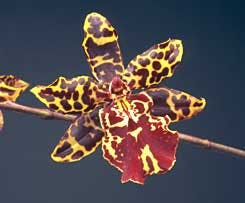
Question
We have 100 orchids of many types and most are doing well. Those that are not, often respond to a change in watering or other cultural adjustment. However, we are having problems with Oncostele Wildcat (formerly Colmanara Wildcat). We grow it in an area with oncidiums, vandas and some cattleyas, but the leaves begin to drop and they look like they are going to die. We grow them in lava rock and water every other day. —Fran Eggars

Oncostele Wildcat, an unnamed clone. Photo © 2009 Greg Allikas
Answer
Many sources do list Oncostele Wildcat as easy to grow, probably because they are almost ubiquitous as potted plants, and because for most people in most areas, they are among the easier orchids to grow. Unfortunately, in South Florida, you face some problems with Ons. Wildcat. Not insurmountable, but problems nonetheless. Many times these plants will not be well established when purchased, and will have been shipped to this region from a cooler climate. We are right on the edge of this type’s temperature tolerance, so if the weather is particularly hot when they are purchased, especially if the roots are not established, the plant will suffer. Oncostele Wildcat can be grown in South Florida, but it must be kept in the coolest part of your growing area, with the best air circulation. Phalaenopsis light conditions are recommended. The best solution may be to repot in the winter and early spring, unlike many other orchids, and take advantage of the cooler season to re-establish so that the plants can better take the summer heat. Lava rock may work, but most plants of this grex do better in, and again unlike most other orchids in South Florida, a fir-bark based medium. — Ned Nash

FREE ACCESS: Orchid DealWire
Get notified when orchid vendors have special promotions and exclusive savings.






